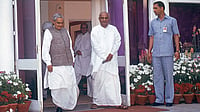
MYTH The IT revolution has been inclusive, providing employment across caste and class barriers.
FACT A majority of IT professionals are from middle-class, educated, urban backgrounds, and upper castes. "Given the large pool of engineering and other graduates available, it is able to select the best students from the best colleges who, because of the exclusionary processes operating within the education system, tend to be from middle-class, urban families," says the report. In the workforce sample, 84 per cent had fathers who were either managers or executives in public and private sector firms, government officers, doctors, professors and businessmen. Only 9 per cent had fathers in clerical or blue-collar jobs, and 3 per cent were from agricultural families.
Firms also look for candidates with the right kind of 'cultural capital'. The report says this for HR managers of software firms: "Several HR managers made an association between language and social background, and identified those from small towns as being the ones with 'communication problems' because of their heavyMTI (mother tongue influence)."
MYTH The IT industry in India is regarded as a model for India's development and rise as an economic power.
FACT The report argues that it is in fact largely an "enclave economy" that is linked to the global economy, with few links to local, regional and national economies due to its concentration on export of software and ITES. The enclave nature of the industry generates few "spillovers" for the domestic economy. India now accounts for 65 per cent of the global market for offshore ITES and 46 per cent of global business process offshoring, and is situated within the global information economy as a provider of primarily low-end services.
During the 1990s, the industry grew at an annual rate of 50 per cent, but since 2000 it has hovered around 28 per cent. This means the industry is dependent on global capital and markets for sustained growth. "This reliance on mercurial global capital and markets means the industry is vulnerable to larger economic forces. A downturn in the US economy, or a decline in India's relative competitiveness due to rising costs, may lead to flight of business and/or capital." The threat of macro-economic shocks holds despite India expanding its markets beyond the US. When such is the case, should it be seen as a model for India's development?
MYTH The IT industry has little to do with state support and has been successful only because of the non-interference of the state and freedom from bureaucratic controls.
FACT The report says: "This story usually neglects to note that the ready supply of skilled manpower was produced by the long period of economic policy based on import-substitution and development of state-driven scientific and technical expertise.... The various technology missions initiated under Rajiv Gandhi's government after 1984, and the new telecom and computer policies that were brought in, provided the infrastructural base on which the industry could grow. " Since the '80s, the industry has enjoyed tax holidays, duty-free import of equipment, free or subsidised infrastructure and land, establishments like software technology parks etc. This growth was further encouraged by liberalisation in the '90s. Technical education has also been grossly subsidised. The report says the absence of acknowledgement of state support is "usually made in defence of their resistance to government regulation of any kind, especially with regard to labour laws".
The report also provides other nuanced analyses—of the position of women in the IT industry, of management control, the labour market, job satisfaction, attrition, migration and other absorbing topics. Unlike many other academic works, this report is accessible both in terms of language and conceptual clarity. Although the final report has been sent to top IT captains there has been "very little feedback" say the researchers, but isn't that understandable?






















